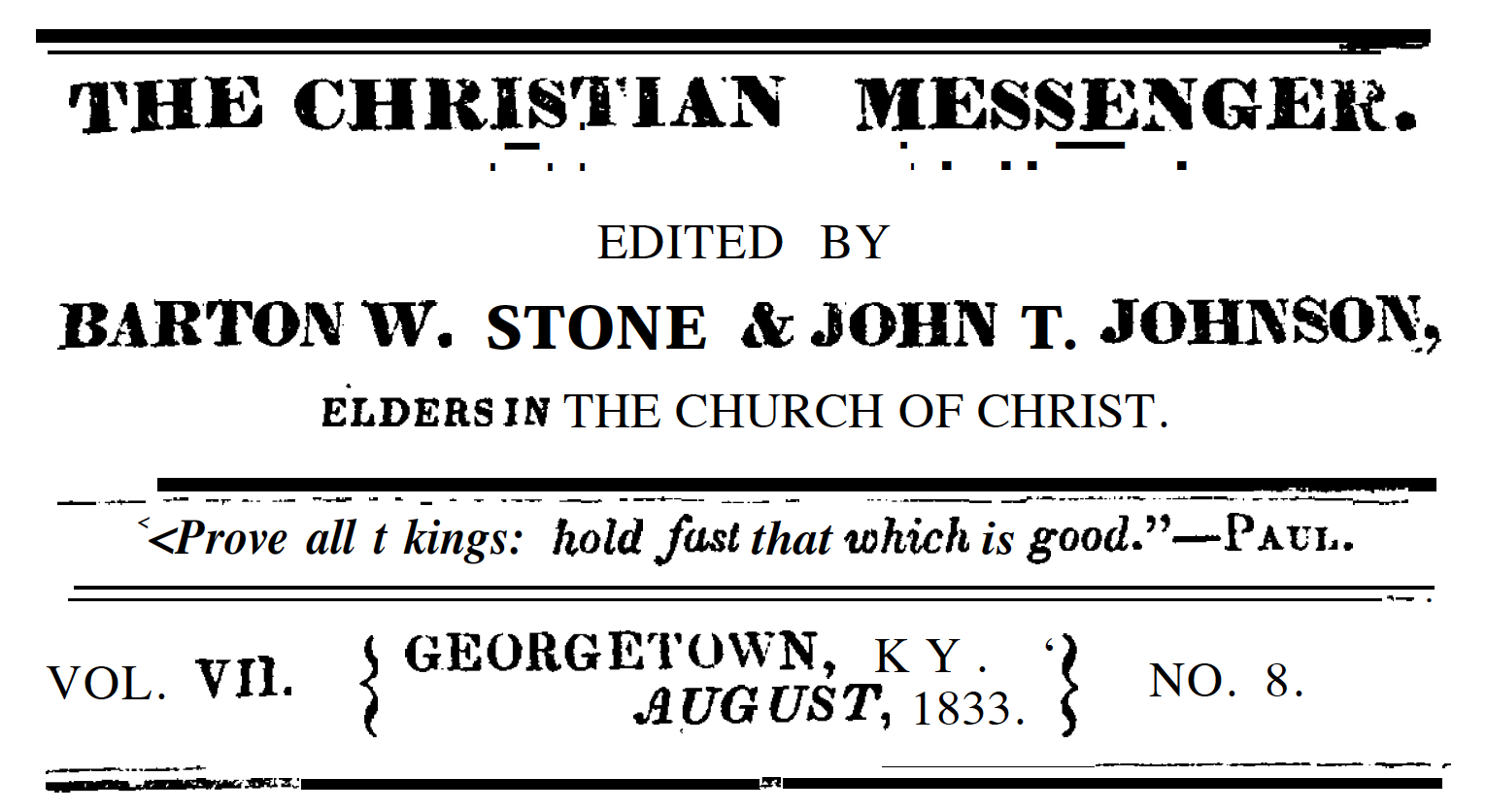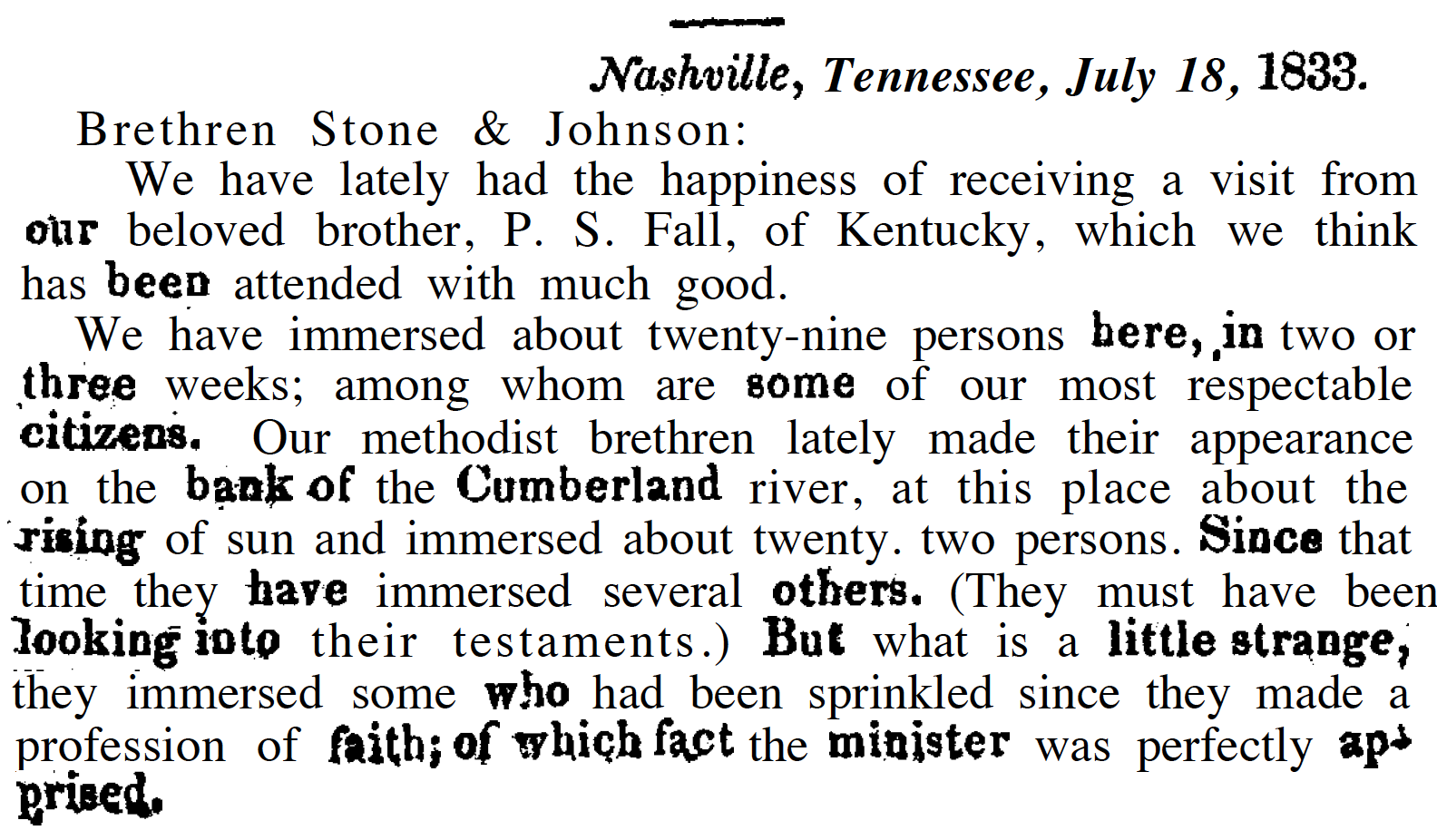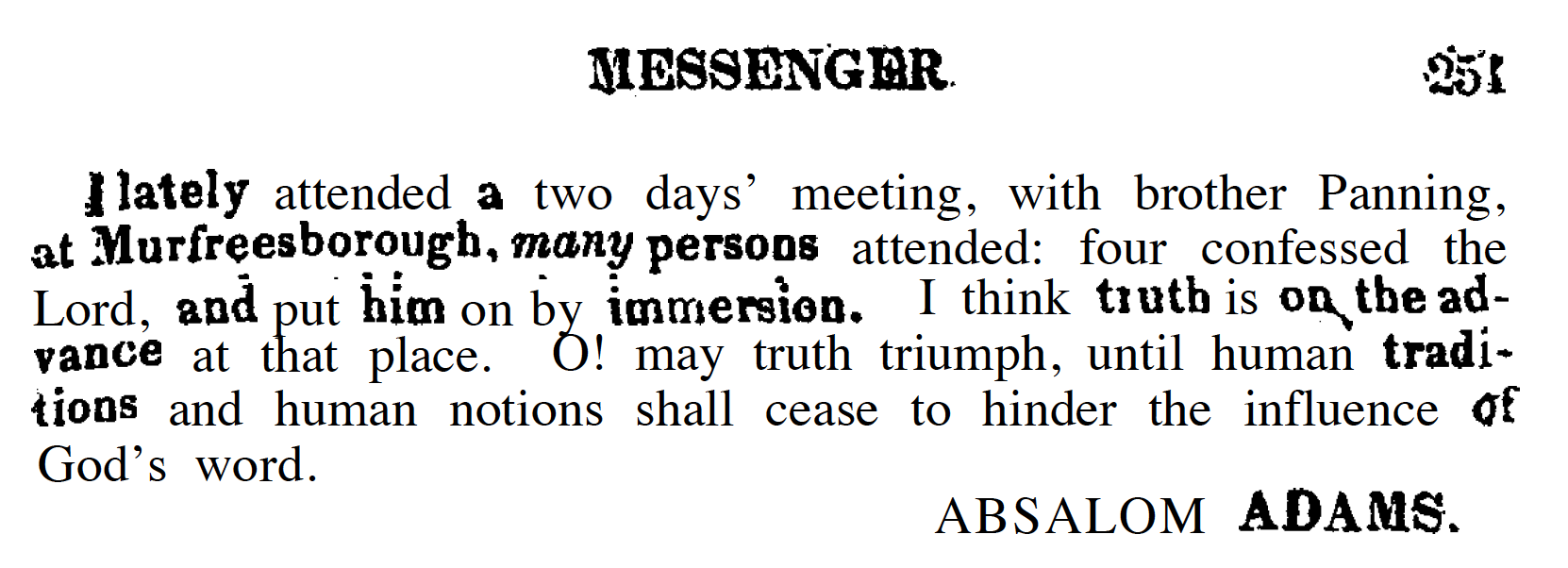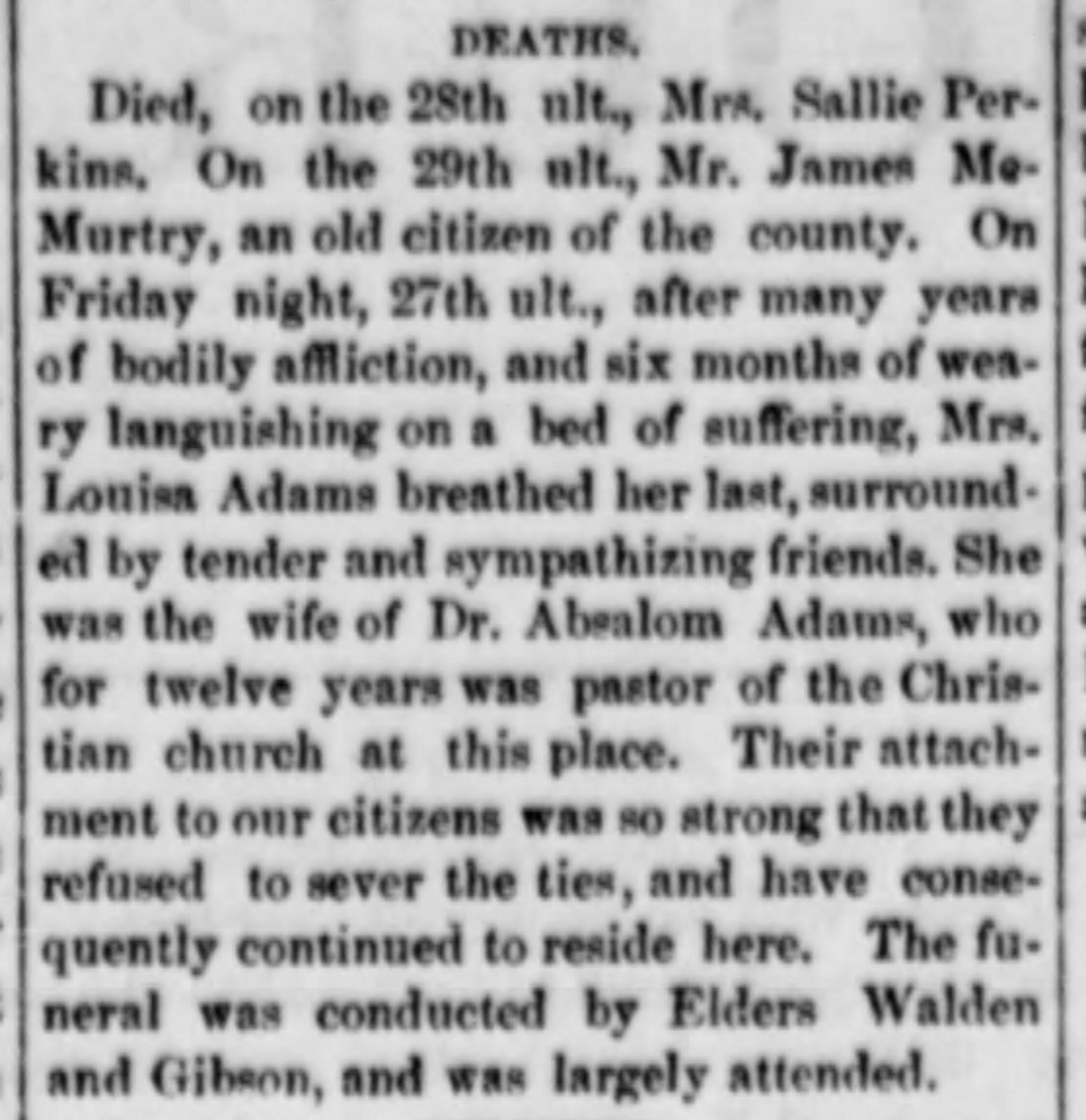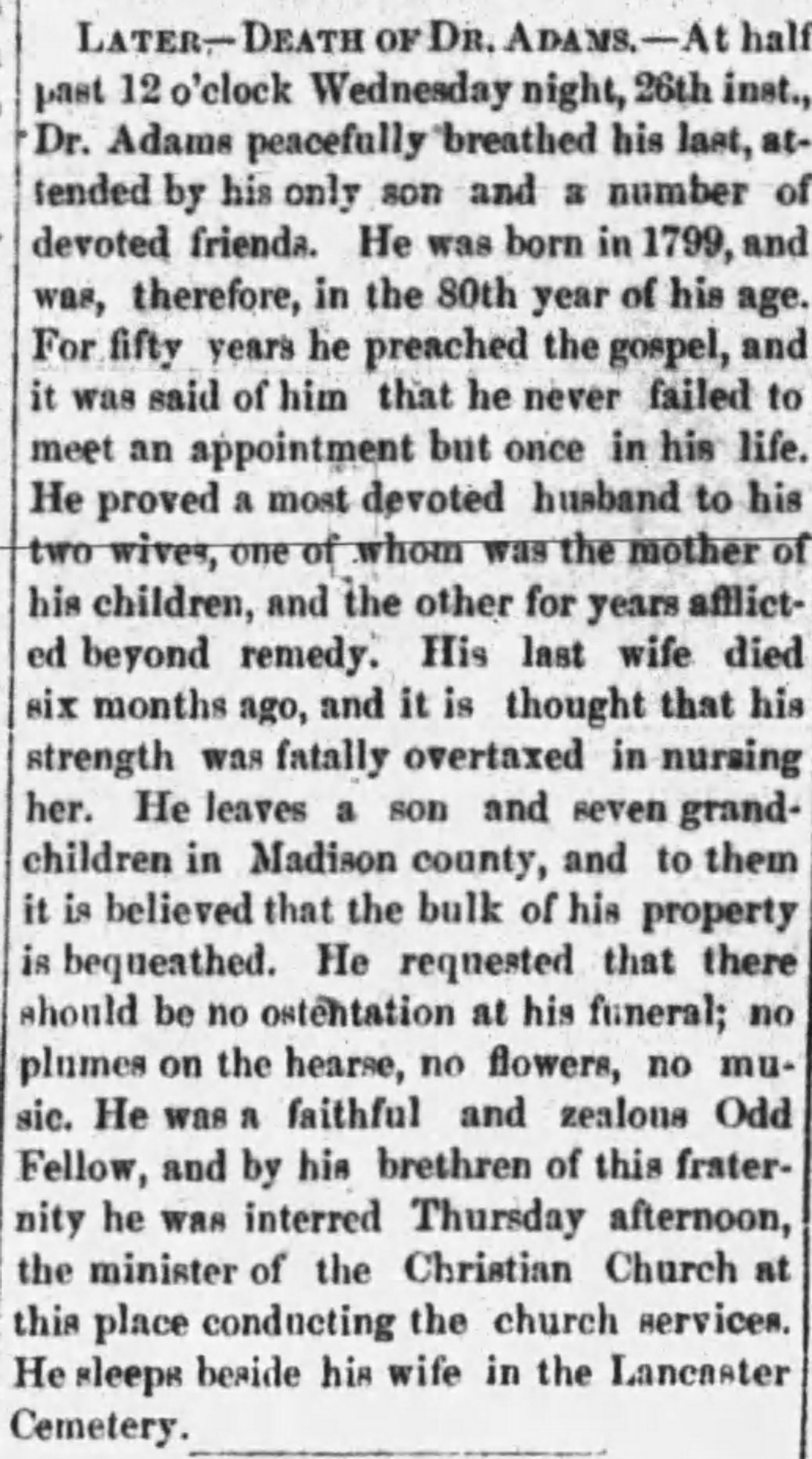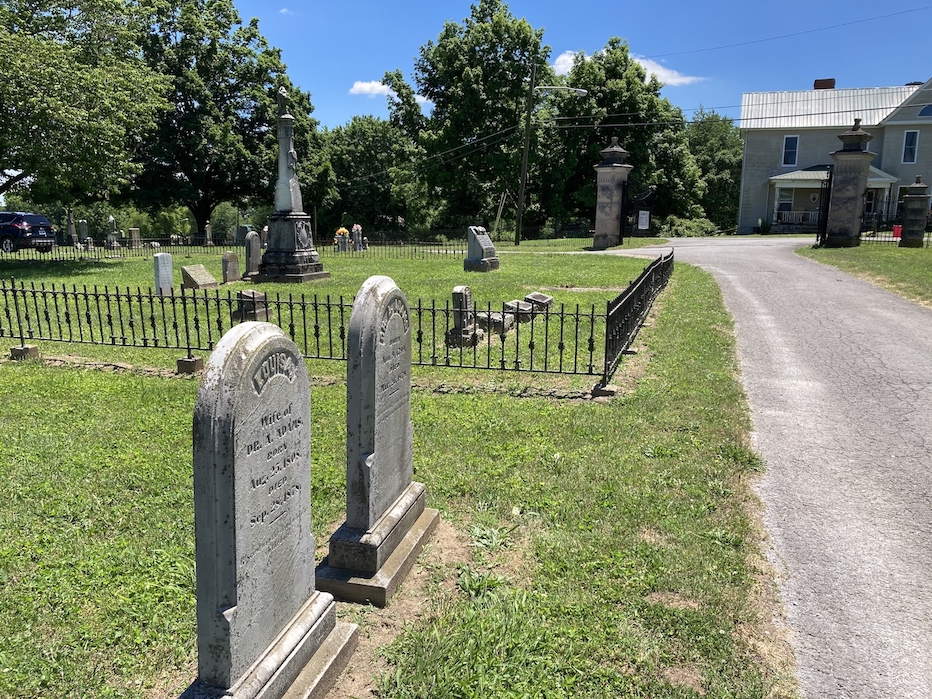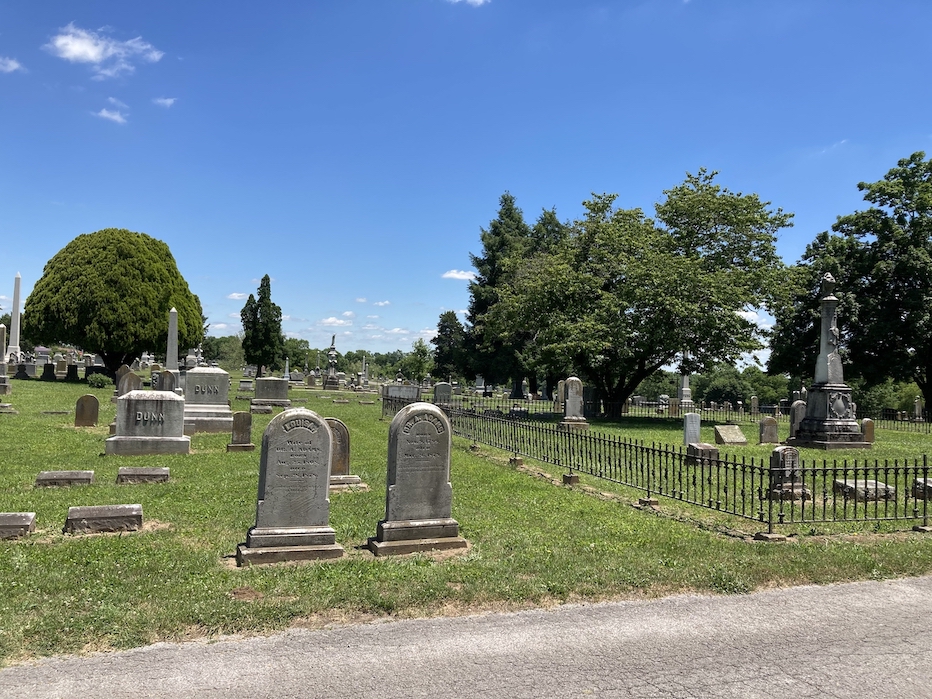Dr. Absalom Adams
1799-1879
[need photo]
![]()
The Life of Absalom Adams III
Absalom Adams III was born in Virginia on November 9, 1799. He was the son of Absalom Adams Jr. (1758-1823) and Mary Feathergill (1760-1823). Little is known of his early age, but it was during that time when his family moved to Todd County, Kentucky, where they were members of the Mt. Gilead Baptist Church. To appreciate the value of his early education in the ways of the Lord, it is proper here to explain a little about the place in history, Mt. Gilead and the churches around them are located.
In this region of southern Kentucky the Second Great Awakening of religious awareness in America began. It was in the adjoining county of Logan, where, in 1799, Revival was being experienced under the preaching of Presbyterian minister, James McGready (1763-1817). Revival took place at the meetinghouses on Red River, Mud River, and at Gasper River. People came from great distances to see what was happening, as all around, they witnessed as others were "getting religion" in a most unexplainable way. Soon, other revivals were taking place in other places, like the Cane Ridge Revival in northern Kentucky, in August 1801, under the direction of Barton W. Stone (1772-1844). All denominations seemed to have been infected by revival during this time, leaving many challenges at the door of Calvinist theology. When the Adams moved to Todd County, they had no idea at how their lives were about to be influenced.
Mt. Gilead was a part of the Bethel Baptist Association. In his exhaustive History of Kentucky Baptists, J.H. Spencer, explained in Volume 2 that the Bethel Baptist Association was born out of the Red River Baptist Association, with eleven churches in all, spanning between Christian, Todd, and Logan Counties. The Mt. Gilead Baptist Church was in Todd County. Spencer explained that the Bethel Association was different from its "mother" group because they were evangelistic. He wrote, "Bethel believed in a sacrifice, adequate to the redemption of all men; that God used means in bringing men to salvation, and that it was the duty of ministers to preach the gospel to all men, warning all to repent and believe the gospel." (p.356) This diversion from Calvinism's purest notions that God only saves the foreordained, a belief firmly held in the Red River Association, was a primary byproduct of the Revival.
In the following lengthy quote, Spencer introduced the influence of Alexander Campbell (1788-1866) on a number of the churches in the Bethel Association, among the leaders of which was a young preacher by the name of Absalom Adams. He wrote, "The teachings of Alexander Campbell began to agitate the churches of this Association, about 1828. During this date, James A. Lindsey gathered a congregation at a place called Noah Springs, which he organized on Mr. Campbell's plan, and which grew quite rapidly, for a time. Absalom Adams, a young preacher raised up in Mt. Gilead church, William T. Major, a licensed preacher in Salem church, another licensed preacher, whose name has not been ascertained, and Isaiah H. Boone, a minister of some ability in Mt. Zion church, also espoused the teachings of Mr. Campbell, and advocated them in the Spirit of that system." (p.358).
The result of Campbell's influence led to the departure of about "five preachers, three ordained and two licensed, with about 70 members" from the Bethel Association (p.359). Spencer only mentioned I.H. Boone (1802-1835) as being the "only preacher of prominence," among the group. The others are not mentioned by name. However, following the information available, it appears that Absalom Adams was among this number.
Within a short time, Absalom played a significant role in the planting of New Testament Christianity in Christian County, Kentucky. From the writings of the long-time church leader, Colonel George Poindexter, comes the following, "The Christian Church was organized in Hopkinsville in November, 1832. Previous to this an open rupture had taken place between those who sympathized with Alexander Campbell in his reformatory movements, and the Baptist Church in Kentucky. This rupture led to much warm contention and strife throughout the State, which, with the action of the Bethel Baptist Association held in Hopkinsville a short time previous, led to and hastened the formation of this church. Three persons who withdrew from the Baptist Church and some few others out of church relation, but baptized believers who were in full accord with Alexander Campbell, with a remnant of the old Christian Church in sympathy with Barton W. Stone, met at the court house on the date above named, and, with the assistance of Isaiah Boone, Dr. A. Adams and William Davenport, an organization was effected." (History of Ninth St. Christian Church, by George Poindexter). He went on to give a list of the first members as well as the results of its earliest work.
Absalom's interest appears to have shifted to Nashville, Tennessee, during this time. By way of background, the early history of the churches of Christ in Nashville was rooted in a determined return to Bible authority. In 1826, the minister among the Baptists was Philip Slater Fall (1798-1890). When the Kentucky preacher arrived, he told the church he had determined only to preach the Scriptures. In 1827 the Baptist Church in Nashville rejected its creed and name entirely and accepted the Bible as its only infallible rule of faith and practice. Known simply as the church of Christ, it sought to follow the New Testament pattern exclusively in church organization, church membership, and worship practices.
While we cannot say with certaintay as to why or when Absalom headed toward Nashville, a good case can be made for December of 1830. Alexander Campbell arrived there for his second of the seven trips he would ultimately make to that city, beginning on the 10th. Accompanied by Jacob Creath, Jr. (1799-1886), he preached for the church several times during the visit. While there, he also debated the Presbyterian minister Obadiah Jennings on the subject of baptism. We would assume that this was Absalom's first opportunity to meet the great sage of Bethany.
Late the next year, another young preacher arrived on the scene in the person of Tolbert Fanning (1810-1874). Young Tolbert had been baptized for the remission of his sins by James E. Matthews (1799-1867) under the preaching of B.F. Hall (1803-1873) in the fall of 1826. Soon determining to preach, he left home in the fall of 1829 to begin evangelizing where he could, mainly in north Alabama and southern Tennessee. The late fall of 1831 is when he arrived in Nashville and joined himself with the band of Christians there. After the first of the year he entered the University of Nashville. Absalom and Tolbert immediately became fast friends and fellow laborers for the church of Christ in that city.
It was right around this time that P.S. Fall suffered illness and announced the need to move back to Kentucky. After his departure, and at Fanning's admonition, the church did not hire another minister but allowed the men of the congregation to do the preaching. So, at thirty-three years of age, Absalom started rotating with Tolbert who was twenty-two, and the others who wished to preach.
Having just left his evangelistic work to go to school, Tolbert Fanning had the gospel so deeply entrenched in his personality and encouraged the brethren at Nashville to be more evangelistic to outlying regions. So, beginning in 1832 and for the next four years, the church sent Absalom and Tolbert out to preach. For the next four years, they preached all through middle Tennessee and established many congregations.
One example of their efforts is the work at Franklin. Alexander Campbell had preached at two different meetinghouses there during his 1830/31 visit to Nashville. But it was not until August of 1833, that Adams and Fanning went down and evangelized there to establish a stable working with seventeen members. That congregation remains to this day and is known as the 4th Avenue church of Christ. Other places included works in Murfreesboro and Rock Spring in Rutherford County, Columbia in Maury County, Lebanon in Wilson County, Shelbyville in Bedford County, and Leiper's Fork in Williamson County. These men preached in brush arbors, schoolhouses, and log cabins to anyone who would listen.

Source: The Historical Marker Database
Another work of note was the Old Union church of Christ in Sumner County. According to their history of this congregation, the work was begun with the preaching of Absalom Adams. By way of a little background, a Baptist minister by the name of Alexander Graham (1811-1851), moved into Sumner County in February of 1834. He had been in Paris, Tennessee, for a couple of years prior operating an academy. As early as 1832, he became acquainted with the teachings of Alexander Campbell and the principles and teachings of the Christian movement. Upon his arrival about four miles east of Gallatin, he came in contact with Dr. John M. Anderson and began sharing his new understandings with him. The two of them invited Absalom Adams to come and preach for them. On Thursday, the 28th of March 1834, Absalom baptized Martha Anderson, the doctor's wife, for the remission of her sins. The Andersons owned a private brick residence that made for a meeting place, and on Saturday evening, the 30th, they conducted the first worship service after the ancient order under the preaching of Absalom Adams. One other person was with the group that day by the name of Elizabeth McKent. (GA, 04.11.1895,p.237) "Miss Betsey," as she was known, was a searcher for the truth. After the preaching, she heard that day, she determined to become a Christian. And, upon the confession of her faith in Christ, Absalom took her that evening and baptized her into Christ. Within just a few days, there were eight members, four who were white and four who were black. (GA 06.28.1894.p.401) At that time, multi-racial congregations were normal in Tennessee and Kentucky. The Old Union church of Christ continues to this day and has enjoyed the preaching of many great restoration preachers like Tolbert Fanning (1810-1874), B. F. Hall (1803-1873), David Lipscomb (1831-1917), E. G. Sewell (1830-1924), E. A. Elam (1855-1929), and many others.
Pressing on in evangelizing all through middle Tennessee, by May 1834, Absalom, being accompanied by Alexander Graham, made his way to the southern part of the state to Franklin County. Just a few miles northeast of Huntland was a small band of Christians in the Bean's Creek community. This group had only a few years previously withdrawn from the Bean's Creek Baptist Church to form a church using the Bible alone as their guide. The group leaders were the Granville Lipscombs along with the families of his brothers Dabney and John. Ann, Granville's wife, had a sister, Elizabeth, who lived in Todd County, Kentucky, in the 1820s. She and her husband, Dr. Lunsford Lindsay, had been Baptists. Similarly connected with the Bethel Baptist Association, they, like the Absalom Adams family, were influenced by the writings of Alexander Campbell. Elizabeth sent copies of the Christian Baptist to Ann, who in turn, shared them with her husband and the families of her brothers-in-law, which led to the founding of the Old Salem church of Christ at Beans Creek. When Absalom Adams arrived to preach for this small body of Christians in May of 1834, Granville and Ann's two little boys were present, five-year-old William, and his three-year-old brother David. Dr. and Mrs. Lindsay were known to have assisted in the preaching of the pure gospel in many places in central and southern Tennessee, undoubtedly supporting of the work of Absalom Adams and so many others. (Note: Earl West, The Life And Times Of David Lipscomb, page 28.)
It was around this time that Absalom left Tennessee and headed to Lexington, Kentucky, to attend medical school at Transylvania University. His studies led him to master the field known as "Mania," which focused on mental disorders. Absalom graduated from Transylvania University with the degree of Doctor of Medicine on March 15, 1837. (The Transylvania Journal Medicine, Vol. 10, No. 1, p.197.) After graduation, he moved to Georgetown and preached for the church there.
Living in Lexington for those nearly three years of school, and then moving to Georgetown to become the preacher of the church of Christ in that city is a testimony to Absalom Adams' rise in popularity and influence. The circles of leadership in the church he entered by being there were among the most noted in the Restoration Movement's early days. Absalom's move to Georgetown was to fill the pulpit vacated by David S. Burnet (1808-1867), the second president of Bacon College. The pulpit there for years before had been filled by John T. Johnson (1788-1856), a man much lauded for the role he played in the unity movement. Most noted of these was the founder of the Christian movement, Barton W. Stone.
By 1834 the united movement of the Christians and Reformed Baptists (Disciples of Christ) was only a couple of years old but was expanding with significant progress through the work of "Raccoon" John Smith (1784-1868) and John Rogers (1800-1867). B.W. Stone was then living at Georgetown where he farmed, preached and produced the Christian Messenger with John T. Johnson. One of the major burdens that bore heavily upon Stone when Absalom came to know him was slave ownership. Brother Stone had a great desire to release his slaves, but the state of Kentucky forbade it. He could not even sell them, because the slaves were bound, not to him, but to his children. Thus, he determined to abandon the slaves by taking his children and moving to a free state. Only in this way could they become free. So, in September 1834, he set his slaves up in a home and ensured they were with adequate provision. Then, he and his family moved to Jacksonville, Illinois, where he spent the remainder of his life.
A letter was discovered in the history of the Mt. Zion Christian Church, Richmond, Kentucky. The letter was written in 1845 when Dr. Adams was then living in North Middletown in Bourbon County. The occasion of the writing was in view of addressing John Rogers, who, at that time, was editing a biography of Barton W. Stone, who had died the previous year. In an attempt to assist Rogers in understanding the reason for Stone's departure to Illinois at the end of 1834, Dr. Adams wrote,
"Bro. Rogers – Dear Sir: There are many little incidents of the history of a man's life which aid very much to develop his true character, and the principles of his heart. And as I am informed you are about to write and publish the Biography of the late venerable B.W. Stone, I have thought the following circumstance would develop much of the goodness and heavenly-mindedness of that good and great man. As you are already informed, there were some servants entailed to his children; consequently he had no power to emancipate them. But (to use his own words,) he determined to free himself from them. And this he did by removing to Illinois and leaving them. If I mistake not, in the year 1838, when I was living in Georgetown, old father Stone was on a visit to Kentucky and spent a night at my house. The servants he had left were living in Georgetown as a family of free persons. The old brother hastened to visit them, and it was my happiness to accompany him. Had he stood in the relation of father, the meeting could not have been more interesting. After full inquiry concerning their temporal and spiritual welfare, and after much religious conversation, advice, and encouragement, he proposed prayer. All present bowed down before God, while his tremulous voice and feeling heart went up to God in devout supplication. Tears flowed from all eyes. The parting scene was truly affecting.
"O, that all masters that profess the Christian religion were thus prepared to unite affectionately in the worship of God with those over whom they exercise authority.
"Your Brother in Christ,
"North-Middletown, June 15th, 1845
"A. Adams" (Facebook link)
Dr. Adams continued his work at Georgetown for several years. As noted, by the mid-to-late 1840s, he and his family were living in Bourbon County preaching and evangelizing in the region. The 1850 U.S. Census shows them still living in the county. He was 51 years of age, and with his wife, Mary C. Adams, was 46.
Absalom was married three times. He was first married to Fanny Davis of Fayette County, Kentucky, on December 14, 1816. They had one child, William Morton Adams (1822-1905). It is assumed that she died sometime around the time of their son's birth because he married once again on September 8, 1824, to Mary C. Holmes, who was born in 1804. Two more children, James, born in 1827, and Prudence (1836-1903) were born to this marriage. At this writing, it is uncertain when and where Mary died, probably around the time he left North Middletown, Bourbon County, and moved to Versailles in 1854. Dr. Adams remarried a final time to Louisa Jesse, a widow in the church at Versailles, Kentucky, December 19, 1854. She passed away on October 4, 1878, a few months before the death of Dr. Adams.
Not long after his marriage to Louisa, the couple moved to Lancaster, Kentucky, where they lived the remainder of their lives. He set up his medical practice there and began immediately reaching out to assist in the works around him. He preached for the Lancaster Christian Church initially. He then started preaching one Sunday a month for the Mt. Zion Christian Church in Richmond. Then, by about 1870, he preached one Sunday a month for the White Oak Pond Christian Church, also in Richmond. These, and others, he continued to support as long as his health would allow. In 1874, the Educational Convention of the Christian Church appointed him to a committee whose work it was to monitor, maintain, and promote Christian education throughout Kentucky. He served with men like I. B. Grubbs, J. B. Briney, John S. Shouse, and many more who were said to be "members of the Christian Church in good standing." (Kentucky Advocate, Danville, Ky, 06.05.1874, p.3)
Dr. Absalom Adams is one of the unsung heroes of the Christian faith in the Restoration Movement's early days. He worked with many of the great and more well-known church leaders, but in his own right, he deserves much praise for the founding of many churches after the New Testament order, and the building up of the body of Christ. Finally, on the 26th of March 1879, he breathed his last. His obituary reported, "For fifty years he preached the gospel, and it was said of him that he never failed to meet an appointment but once in his life." (Interior Journal, Stanford, Ky 03.28.1879.p2) His body was laid to rest beside Louisa's in the Lancaster Cemetery in Garrard County, Kentucky.
-Scott Harp, 07.01.2020
![]()
Interior Journal, Stanford, Kentucky
Friday, July 27, 1877, page 3.
![]()
Report In The Christian Messenger In 1833
Absalom Adams, Christian Messenger, Vol. 7, No. 8, August 1833, page 251
Note: "brother Panning" refers to Tolbert Fanning
![]()
Death of Louisa Adams
Interior Journal, Stanford, Ky
Friday, October 4, 1878, page 2
Died . . .On Friday night, 27th ult., after many years of bodily affliction, and six months of weary languishing on the bed of suffering, Mrs. Louisa Adams breathed his last, surrouded by tender and sympathizing friends. She was the wife of Dr. Absalom Adams, who for twelve years was pastor of the Christian church at this place. Their attachment to our citizens was so strong that they refused to sever the ties, and have consequently continued to reside here. The funeral was conducted by Elders Walden and Gibson, and was largely attended. (Transcription)
![]()
Death Of Dr. Absalom Adams
Interior Journal, Stanford, Ky
Friday, March 28, 1879, page 2
Later—Death of Dr. Adams—At half past 12 o'clock Wednesday night, 26th inst., Dr. Adams peacefully breathed his last, attended by his only son and a number of devoted friends. He was born in 1799, and was, therefore in the 80th year of his age. For fifty years he preached the gospel, and it was said of him that he never failed to meet an appointment but once in his life. He proved a most devoted husband to his two wives, one of whom was the mother of his children, and the other for years afflicted beyond remedy. His last wife died six months ago, and it is thought that his strength was fatally overtaxed in nursing her. He leaves a son and seven grandchildren in Madison county, and to them it is believed that the bulk of his property is bequeathed. He requested that there should be no ostentation at his funeral; no plumes on the hearse, no flowers, no music. He was a faithful and zealous Odd Fellow, and by his brethren of this fraternity he was interred Thursday afternoon, the minister of the Christian Church at this place conducting the church services. He sleeps beside his wife in the Lancaster Cemetery. (Transcription)
![]()
Directions To Grave
Abasalom Adams is buried in the Lancaster Cemetery located on Crab Orchard Rd., in Lancaster, Kentucky. The GPS location below is the actual location of the grave in the cemetery. However the grave is easy to find. Enter the cemetery and go left. You will immediately see a plot encircled by an iron fence. Just to the left of the fenced-in area and facing the drive is the plot of Dr. Absalom Adams.
GPS Location
37°36'58.8"N 84°34'33.9"W
or D.d. 37.616320,-84.576082
![]()
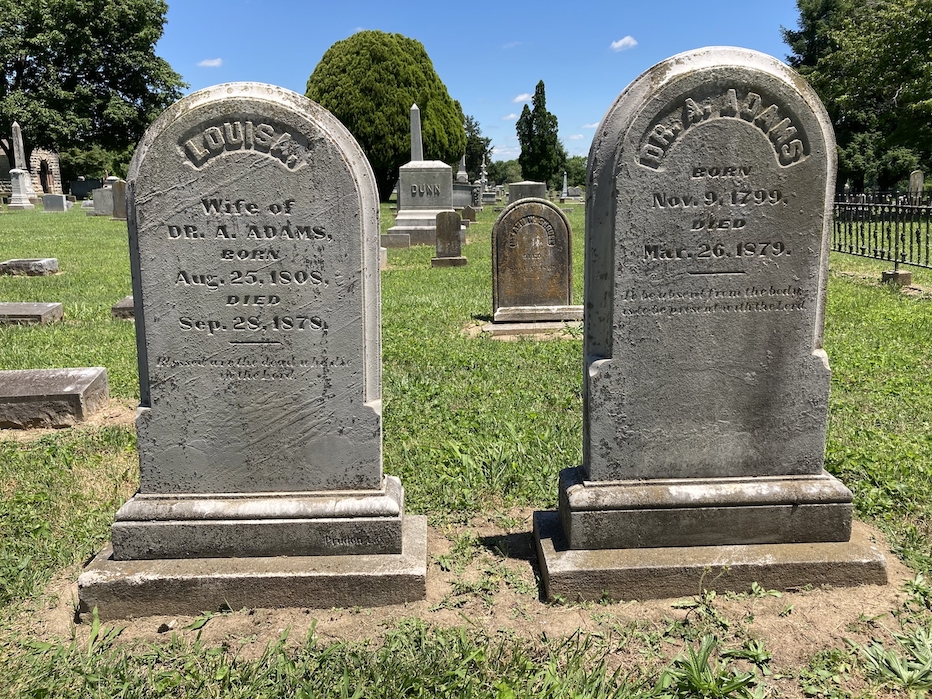
Louisa
Wife of
Dr. A. Adams.
Born
August 25, 1808
Died
September 28, 1878
Blessed are the dead who die
in the Lord
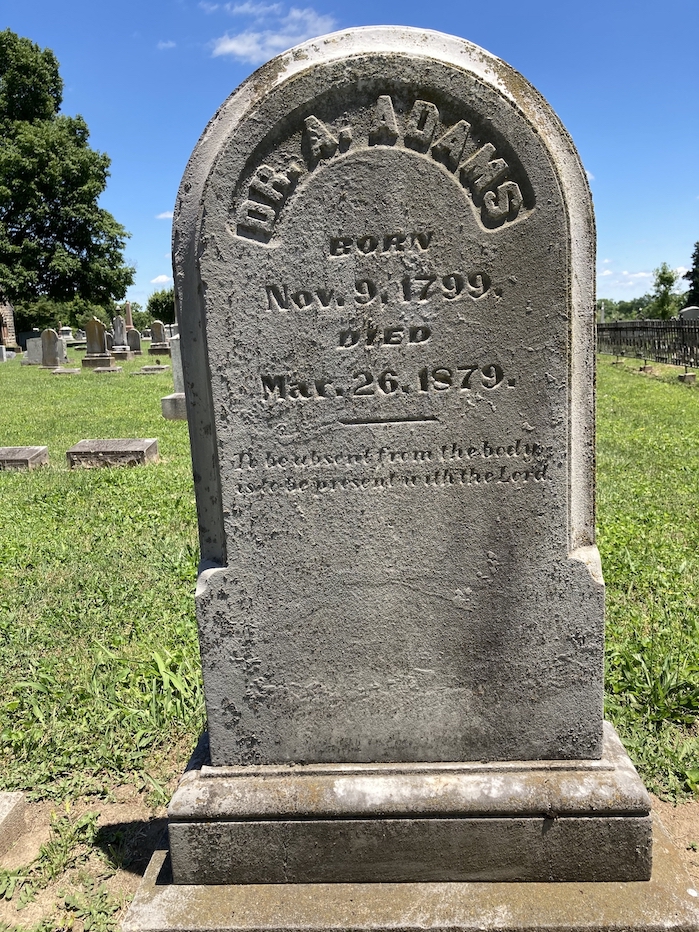
Dr. A. Adams
Born
November 9, 1799.
Died
March 26, 1879.
To be absent from the body,
is to be present with the Lord.
![]()
Photos Taken 06.11.2020
Webpage produced 07.01.2020
Courtesy Of Scott Harp
www.TheRestorationMovement.com
Special Recognition: Special thanks to Garry L. Hill who assisted me in the location of the grave of Dr. Absalom Adams. We took a day trip to north central Kentucky, visiting several graves of gospel preachers of yesteryear.
![]()

